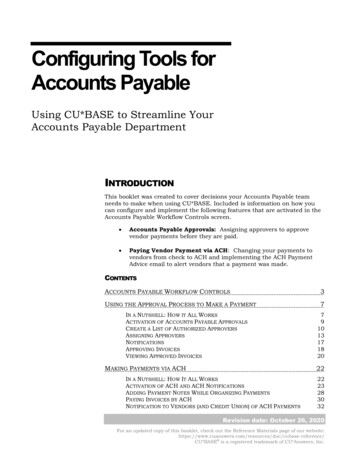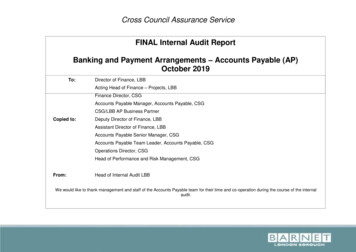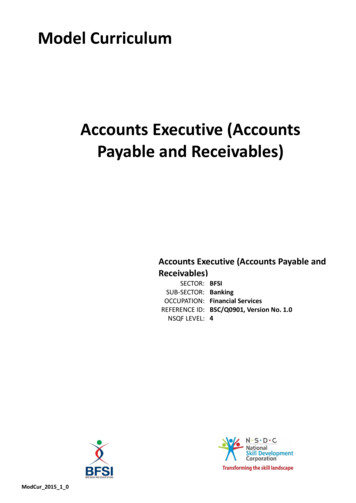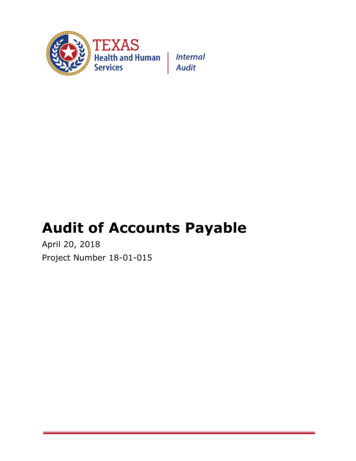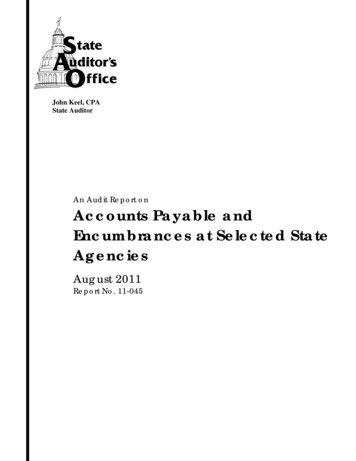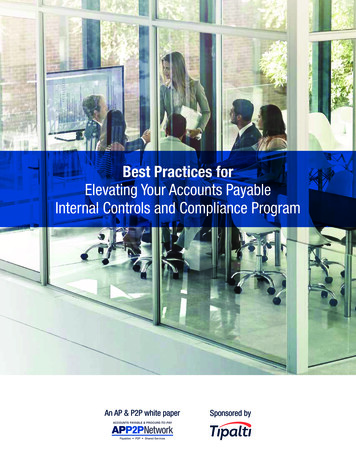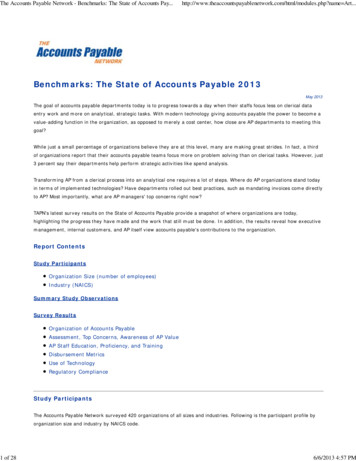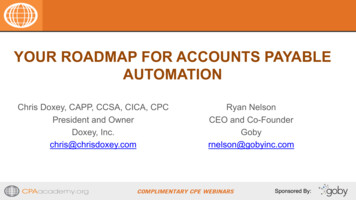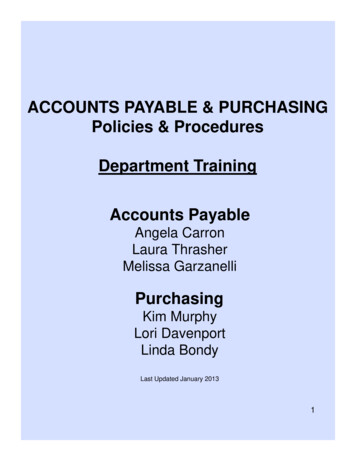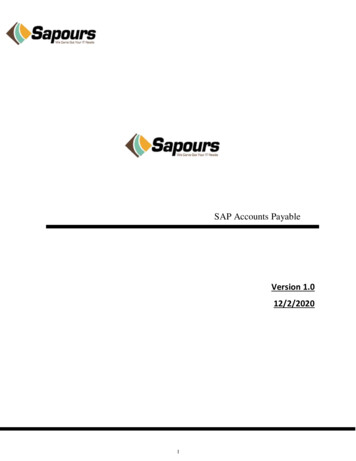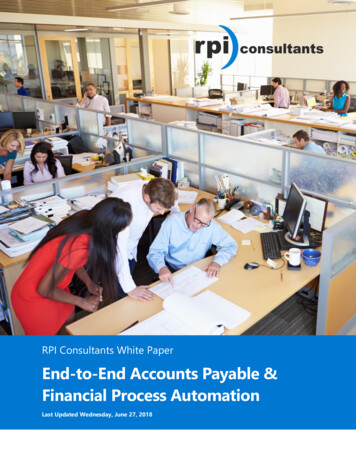
Transcription
RPI Consultants White PaperEnd-to-End Accounts Payable &Financial Process AutomationLast Updated Wednesday, June 27, 2018
RPI Consultants White PaperEnd-to-End Accounts Payable AutomationTable of ContentsOverview . 3Product Recommendations . 3Accounts Payable Automation. 4Invoice Capture . 5Header Data Entry and GL Line Coding . 6Approval Routing . 11Payment Processing. 13Reporting & Analytics . 14About RPI Consultants. 16Learn more about RPI Consultants at www.rpic.com.Page 2
RPI Consultants White PaperEnd-to-End Accounts Payable AutomationOverviewAccounts Payable departments are constantly being asked to simultaneously reduce costs and improveservices in an effort to save time and money. Many of the errors, exceptions, and delays occur in theProcure to Pay (P2P) process while processing invoices for payment and procuring resources andmaterials. This is largely due to manual data entry and processing that is often required for invoice coding,validation, and approval routing.In an effort to reduce errors, processing time, andcosts, many organizations are now choosing to investin workflow automation products, such as EnterpriseResource Planning (ERP) platforms, EnterpriseContent Management (ECM) software, andIntelligent Data Capture with Advanced OCR. Theseplatforms can be used independently or integrated invarious ways to reduce or eliminate manual data entryand processing across many departments, includingAccounts Payable.Each organization and implementation are unique, andcustom data integrations or additional products maybe required for complete automation. However, in thiswhite paper we will share industry standards and bestpractices for implementing a basic automationsolution in a typical accounts payable department.For more information on how to automate youraccounts payable department, please feel free tocontact us at www.rpic.com.Automation TechnologyEnterprise Resource Planning (ERP)ERP platforms integrate data and workflows thatsupport important business processes, such asplanning, purchasing, sales, inventory management,accounts payable, and human resources.Enterprise Content Management (ECM)ECM platforms capture, manage, and store contentacross an organization, including records,documents, images, or electronic messages.Intelligent Data CaptureIntelligent Data Capture refers to software thatintelligently reads scanned and electronicdocuments to extract key data and words usingAdvanced Optical Character Recognition (OCR).Product RecommendationsThere are many software providers and vendors for each type of product mentioned in this article, and RPIConsultants has experience with nearly all of them. Based on our extensive product and projectexperience we have selected only a few as active partners that we recommend to our clients.ERPECMLearn more about RPI Consultants at www.rpic.com.ECM, IntelligentData CaptureIntelligent DataCaptureECMPage 3
RPI Consultants White PaperEnd-to-End Accounts Payable AutomationAccounts Payable AutomationThere are a lot of active processes and workflows across the Accounts Payable department, but invoiceprocessing typically requires the most attention, time, and resources. Getting invoices paid on time, orearly, prevents penalties, creates opportunities for discounts, and ensures that products, materials, andresources are available to help the business operate.At the center of this process is the invoice, which is why AP Automation focuses on invoice capture,coding, validation, and approval routing. The following graphic demonstrates how Intelligent DataCapture, ECM, and ERP applications can be used at different steps of AP Automation.Invoice Processing Process and Automation TechnologyMost AP Automation solutions include some combination of ECM, Intelligent Data Capture, and dataintegration with an ERP. Typically, the ECM platform will be designed to capture invoices from differentsources and then pass them to an Intelligent Data Capture product. Header Data and/or GL Coding datawill be automatically extracted and verified and then exported back into an ECM workflow with the invoiceimage. Any remaining coding, exception handling, or coding verification will be completed by workflowusers.Learn more about RPI Consultants at www.rpic.com.Page 4
RPI Consultants White PaperEnd-to-End Accounts Payable AutomationAt this point, invoices may be routed for approval using the ECM workflow, or invoices may be exportedto the ERP for more robust approval routing. Additional products, such as RPI’s proprietary Yoga SMSApprovals, may be used with your ECM or ERP workflow to facilitate approvals via SMS text. When allapprovals have been captured, the invoice payment can be processed.Invoice CaptureThe invoice is the driving document in AP Automation, and so the first step of any AP Automationsolution is to capture the invoice into your system. Invoices are often available in a variety of formats,including paper invoices delivered by mail or fax, invoice images received via email, and even electronicinvoices sent via Electronic Data Interchange (EDI). This means that any software you use to captureinvoices will need multiple capture methods.Scanned InvoicesScanning documents is the simplest method to capture physical invoices received through the mail or fax.Scanners and capture solutions can be set up with varying levels of image correction and manipulationoptions to ensure that scanned invoices are legible and ready to be processed. Once captured andchecked for quality, invoices are then routed into your Intelligent Data Capture or ECM workflow forheader data entry and GL coding.Imported InvoicesFile import is a convenient capture method that can be configured to import invoices directly from aserver or a shared network directory. This is especially helpful in situations where invoices are beingscanned in through Multi-Function Devices (MFDs) from multiple users across decentralized locations ordepartments. It can also be used when a third-party fax service is being used to capture and exportphysical faxes to a shared network directory.Each ECM platform will have multiple import methods and configuration options, including everythingfrom manual imports, scheduled import tasks, and real-time import monitoring services. Each import jobcan have unique import settings, which allow you to use the filename or an associated data text file toimport images and apply keyword indexing. Imported files can be moved directly into your IntelligentData Capture or ECM workflow for header data entry and GL coding.Emailed InvoicesMany ECM products include email capture services or modules that monitor email accounts to importmessages and attachments. These features include Perceptive Content’s (ImageNow) Email Agent andHyland OnBase’s Mailbox Importer. Imported documents can be indexed with data from the email andautomatically routed to your Intelligent Data Capture or ECM workflow.For some of RPI’s clients, these products do not provide sufficient data auditing or indexing options. Tosolve this problem, RPI developed its own proprietary product called EC Service. Similar to other products,EC Service monitors inboxes, downloads attachments from emails, and automatically preparesattachments for indexing and import into your ECM platform. However, RPI’s EC Service also stores allemail and attachment data in a separate database for advanced auditing and reconciliation, which canalso be used to create scheduled reports.Learn more about RPI Consultants at www.rpic.com.Page 5
RPI Consultants White PaperEnd-to-End Accounts Payable AutomationElectronic Data Interchange (EDI)The core motivating factor behind AP Automation is to reduce time spent on manual data entry andprocessing. If a company receives a large number of invoices from a single vendor, it may make sense towork with that vendor to receive invoices through Electronic Data Interchange (EDI). This format allowsvendors to send raw invoice data through an EDI clearing house rather than preparing and sendingphysical invoices through the mail. Invoice data is converted into an EDI file, typically referred to as an 810document, and then delivered to the company via email or SFTP.EDI files make it easier to prepare and process large amounts of invoices by eliminating the need tomanually review and extract raw invoice data and GL line items. However, you will still need to ensure yourERP, ECM, or Intelligent Data Capture solution is configured to import, parse, and in the case of ECM,generate readable invoice images from the EDI file.Header Data Entry and GL Line CodingHeader Data Entry and GL Line Coding is often thesource of most invoice errors, exceptions, and delaysin processing. This is especially true when APProcessors manually review and enter data frominvoice images into an ERP or ECM platform.When mistakes occur, hopefully they are found duringa validation step but often they are found by theapprover. In either case, mistakes force the invoicesback to AP Processors for correction.Automating data entry and GL coding saves time andmoney by reducing or completely eliminating thereliance on manual data entry or processing. At aminimum, automation solutions can extract headerdata and route invoice images in a digital workflow.This allows AP Processors to work faster and APManagers to better track and audit invoice exceptions.At best, solutions with Intelligent Data Captureproducts will identify, extract, and validate 100% ofinvoice data and completely automate the hand off forinvoice approval routing. This includes both headerand line item extraction with line pairing logic, whichnearly eliminates all manual data entry.Sample Invoice with Header & Line Item DataLearn more about RPI Consultants at www.rpic.com.Page 6
RPI Consultants White PaperEnd-to-End Accounts Payable AutomationIntelligent Data Capture with Advanced OCRIntelligent Data Capture is at the core of any AP automation solution and can be used to perform simpletasks, such as extracting and applying header data to captured invoices, or extremely complex tasks, suchas validating data against outside data sources like an ERP or vendor database.There are many Intelligent Data Capture products available, but most will share core features and follow aprocess similar to the following:1.Intelligent Data Capture utilizes Advanced Optical Character Recognition (OCR) to read an imageand recognize characters the same way as a human would.2.Using the recognized characters, or based on pre-configured templates, the image is classified bytype, such as PO or non-PO invoice.3.Based on the image classification, header data and/or line item data is extracted and validatedagainst an ERP, vendor database, or other data source.4.Validated invoices and are exported to be processed within an ECM or ERP workflow.Sample Invoice Data Verification Screen in Kofax KTALearn more about RPI Consultants at www.rpic.com.Page 7
RPI Consultants White PaperEnd-to-End Accounts Payable AutomationVerificationDuring the data extraction and validation steps, each piece of capture data is weighed against aconfigured confidence percentage. If a certain value does not meet the OCR engine's confidencethreshold, the image will be routed to a manual verification step. Most products will include a separatequeue or view for these documents and highlight the failed fields. From here, users can manually verifythe field to continue and complete document processing.Sample Verification Screen in Kofax ReadSoft OnlineExceptionsThe verification step will also typically allow users to assign exceptions. Assigning an exception will allowthe document to process out of the Intelligent Data Capture solution but will send the exporteddocument and data with an invalid reason code. When the invoice moves back into the ECM or ERPworkflow, the document will route to an exception queue where someone can review the invalid reasonand resolve any issues with the invoice.Sample Exception Processing in Kofax KTALearn more about RPI Consultants at www.rpic.com.Page 8
RPI Consultants White PaperEnd-to-End Accounts Payable AutomationInvoice Coding with eFormsWhen performing header data and GL coding in an ECM workflow, Electronic Forms (eForms) are crucialto automating time intensive tasks like data validation, integration, and payment posting. eForms arevisual representations of invoice, vendor, PO, and GL Coding data that are attached to the invoice recordor document. eForms drive automated data validation, either through client-side or server-side validationagainst outside data sources (see Header and GL Coding Validation).AP eForms are typically created and attached to an invoice after it has been captured or imported intoyour ECM workflow. If the invoice has passed through an Intelligent Data Capture solution, any and allextracted data from the invoice will automatically be populated into the eForm. AP Processors will be ableto edit or manually fill AP eForms following capture or as a way to manage rejected invoices for incorrectcoding.Sample Invoice with Perceptive Content AP eFormLearn more about RPI Consultants at www.rpic.com.Page 9
RPI Consultants White PaperEnd-to-End Accounts Payable AutomationHeader and GL Coding ValidationCapturing and storing invoice and GL coding datadoesn't provide value if it isn't correct. That’s why mostinvoice processing workflows will include multiplevalidation steps against outside data sources, such asERPs, accounting systems, vendor databases, etc.Validation usually follows immediately after any queueor step where users are allowed to make edits to theinvoice indexing or eForm data. This ensures that anymistakes in data entry or data capture are not passedon to the next step in the process or to the ERP forpayment processing. When mistakes are identified, theinvoice is routed back to exceptions queues or views.There are two primary validation types: client andserver. A client validation is triggered in your ECM orERP during data entry or on demand. For example, if auser is coding into an eForm there may be built invalidations on each field or a validate button thattriggers validation logic. The server validation is tied toworkflow queues or invoice processing steps and runwhenever an invoice is routed forward.There are infinite possibilities for validating invoicedata, although there are some common validationsthat most organizations will include. In addition torequired fields, data validations can be performed forvendor information; PO Number, Line Pairing, andDistributions; GL Coding, Accounts and Distributions;and currency, tax code, and VAT total.Separate from client and server data validations, thereshould also be checks for duplicate invoices. Typically,this step will combine Vendor ID, Invoice Number, andInvoice Amount to perform a search against activeinvoices. If a duplicate is discovered, the invoice willroute out to an exception queue or view for additionaluser review.Learn more about RPI Consultants at www.rpic.com.Sample Validation Logic for Perceptive AP eFormPage 10
RPI Consultants White PaperEnd-to-End Accounts Payable AutomationApproval RoutingApproval Routing is another time intensive step ininvoice processing that requires complex logic andconsistent follow up. Based on your individualenvironment and system architecture, ApprovalRouting can be completed in either your ERP or ECMsystem.For example, validated invoices and eForm data can bepassed to an ERP immediately following validation,and the ERP could manage all approval routing,notifications, and follow up. Alternatively, yourapproval routing logic and matrix could be created inyour ECM system.Sample Invoice Approval Workflow in Perceptive ContentConsider your product capabilities, notifications, andlicensing to make the best decision for your organization.Approval MatrixThe approval process starts with the Approval Matrix.An Approval Matrix is a complex set of conditions thatmatch approvers, invoice types, dollar thresholds,approval levels, and departments within anorganization.For most ECM implementations, the Approval Matrix isstored as a flat file and regularly updated. However,the Approval Matrix may also be stored in a separatedatabase or within the ERP platform itself. WhenApproval Matrixes are stored outside of an ECMsolution, database connections or direct integration isrequired for automated Approval Routing.Approval Matrix in Hyland’s OnBase Approval ManagerThe Approval Matrix is leveraged by the ECM or ERPsolution to evaluate each invoice and route to one ormore approvers. Based on the GL Account Code, Invoice Amount, and Department, the invoice will berouted to the first appropriate approver. Following the first and every subsequent approval, the invoicewill again be evaluated against the Approval Matrix to determine if there are any further approvalsrequired. Once the invoice has received all of its approvals, the invoice completes the approval processand moves forward for payment processing.Learn more about RPI Consultants at www.rpic.com.Page 11
RPI Consultants White PaperEnd-to-End Accounts Payable AutomationApproval NotificationsTo encourage timely approvals, your Approval Routingsolution should include Approval Notifications.Notifications are important, especially for approverswho do not approve invoices regularly and are not inthe habit of checking an approval queue or list.Depending on your ECM or ERP system, notificationscan be sent via email, SMS, or integrated into otherbusiness applications. For example, Hyland’s OnBaseoffers integration for Microsoft Outlook which allowsusers to approve or reject invoices within Outlook.OnBase Integration for Microsoft Outlook(See our Webinar)For Email and SMS notifications, your organization’sECM or ERP features may allow for adding weblinks to the appropriate invoice, queue, or list.Rejection ReasonsOccasionally, an invoice needs to be rejected whenthere are cost discrepancies, issues with the vendoraccount, or other problems that require resolutionprior to payment processing. The Approval Routingsolution should be configured or provide the approverwith Rejection Reasons and the option to addadditional comments.Rejection Reasons provide information for the usersprocessing rejected invoices and reduces the timespent tracking down or resolving the issue.Rejection Reasons in Perceptive ContentApproval Escalation & Backup ApproversOne of the least dependable aspects of Approval Routing are often the Approvers themselves. Across anorganization, any number of people responsible for approving invoices may be traveling for business,vacation, or just unavailable for days at a time. This creates a bottleneck for Approval Routing andPayment Processing which could cost an organization early pay discounts or even late payment penalties.To ensure invoices are always approved and paid on time, ECM and ERP solutions offer the ability to setup Escalations and Backup Approvers. The Escalation threshold is set in the Approval Matrix and definesthe number of days or business days an invoice can go without receiving an approval or rejection fromthe assigned approver. If that threshold is met, the invoice is escalated to the next level approver.To address approvers on paid time off, most ECM and ERP solutions will also provide the ability toconfigure Backup Approvers. Assigning a backup will allow a different user to perform invoice approvalsfor that department while the approver is out of the office.Learn more about RPI Consultants at www.rpic.com.Page 12
RPI Consultants White PaperEnd-to-End Accounts Payable AutomationPayment ProcessingWhen invoice images and data have been handed offor integrated to an ERP from an ECM solution, invoicesare typically held in a pending queue for PaymentProcessing. The handoff could occur prior to orimmediately following Approval Routing, dependingon which system is being used (for Approval Routing).Either way, the ECM solution will hold invoice imagesuntil they can be matched and linked to the paymentrecord or check number.The ECM solution will run a scheduled task to connectdirectly to the ERP or check a secure directory forPayment Details Indexed to Invoice in Perceptive Contentcheck images and payment information. When thoserecords are found, check images may be imported andindexed, and invoices are updated with check numberand payment information. This entire process can be customized to import and index as much or as littleinformation needed, based on business requirements and ERP capabilities. When payment information isapplied to an invoice, it can be routed out of workflow and archived.In a situation where a payment is never processed for an invoice, the invoice needs to be routed ormarked as an exception. Within your AP Automation solution, an unprocessed payment threshold can beset according to business requirements, however a typical timeframe is 45 days. If the threshold is met,the invoice will automatically route to an exception queue or view. This will let administrators know thatpayment still has not been submitted for the invoice and allow users to troubleshoot the issue.Learn more about RPI Consultants at www.rpic.com.Page 13
RPI Consultants White PaperEnd-to-End Accounts Payable AutomationReporting & AnalyticsOne of the biggest benefits to AP Automation is the immediate and easy access to all invoices and invoicedata at every point in the invoice processing workflow. This data availability creates the opportunity forpowerful Reporting & Analytics, available to help AP leaders identify bottlenecks in the process, measureuser performance and proficiency, and drive down invoice aging for vendor discounts and benefits.Reports can be created for almost any type or request, but the most common reports for AP Departmentsare Accrual Reports, Users Statistics, and Workflow Statistics.RPI's Yoga Dashboard for AP Workflow Snapshot(See our Webinar)Accrual ReportingAccrual Reporting demonstrates which invoices and invoice totals are currently being processed orawaiting final approvals. These are invoices that have not yet posted to your ERP for payment processing.This report can be scheduled to run and deliver to a group of users and can retrieve any index value oreForm value associated with the invoice.Sample Accrual Report from Perceptive Content Business InsightsLearn more about RPI Consultants at www.rpic.com.Page 14
RPI Consultants White PaperEnd-to-End Accounts Payable AutomationUser StatisticsUser Statistics reporting visualizes statistics for specific user accounts in your ECM. This report can showhow many documents a particular user or group of users have processed and will help identify areas thatmay need assistance with load balancing. For example, if users in one department are processingsignificantly more invoices than another department, it could be an indication that the users in the seconddepartment need additional training or support.Workflow / Process StatisticsWorkflow and Process Statistics reports help identify how quickly invoices are moving through the entireinvoice coding and approval process. This report uses status changes or workflow queue aging data togive a high-level view of how long it actually takes for invoices to be coded, approved, and paid. With thisinformation, you can set benchmarks to forecast payments and identify and get ahead of bottlenecks. Thisreport can also help identify where you may need process or workflow redesign to improve efficiency.Workflow / Process Statistics Report Sample (Perceptive Content)Learn more about RPI Consultants at www.rpic.com.Page 15
RPI Consultants White PaperEnd-to-End Accounts Payable AutomationAbout RPI ConsultantsRPI Consultants is a leading ERP and ECM professional services organization with extensive experiencedesigning, implementing, and supporting Infor Lawson, Perceptive Content (ImageNow), Kofax, OnBaseby Hyland, and Brainware by Hyland (formerly Perceptive Intelligent Capture). RPI employs approximately100 full time consultants, developers, and solution and technical architects with specific experience andexpertise across many industries and solutions. RPI is based out of Baltimore, Maryland, with additionalpermanent offices in Tampa, Florida, and Kansas City, Missouri.RPI provides professional and technical services for new installations and upgrades, solution and technicalhealth checks, new solution designs and implementations, custom development and system integrations,custom training, and environment and product migrations. RPI is also an authorized license reseller. Formore information about RPI Consultants, including professional services, license requests, and generalinquiries, visit www.rpic.com.Learn more about RPI Consultants at www.rpic.com.Page 16
RPI Consultants White Paper End-to-End Accounts Payable Automation Learn more about RPI Consultants at www.rpic.com. Page 3 Overview Accounts Payable departments are constantly being asked to simultaneously reduce costs and improve services in an effort to save time and money. Many of the errors, exceptions, and delays occur in the
